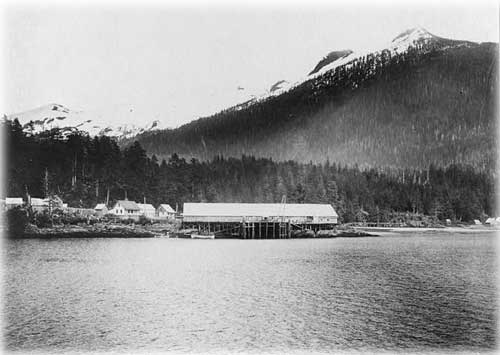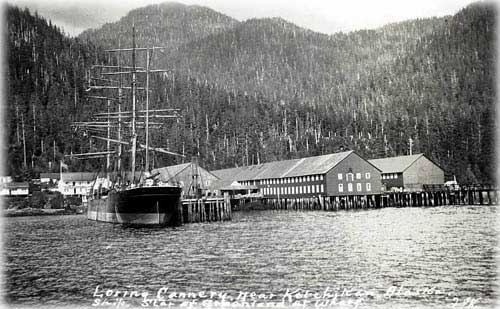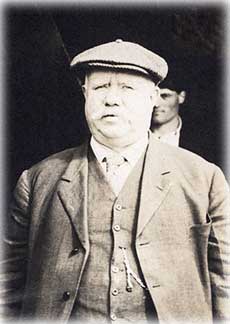 Ketchikan took shape 120 years ago By DAVE KIFFER April 07, 2007
The owners of a salmon cannery in Boca de Quadra were moving it to the mouth of a large fish stream in the Narrows and hoping to build a community around that stream. The community would eventually be named Ketchikan. It was not the first effort to populate the Tongass Narrows area. Tlingit Natives had been coming to the area for untold generations to take advantage of the salmon stream. Some had even apparently tried to live year round in the Narrows area, but most returned to the better weather slightly to the south in the Cape Fox and Village Island area.  Forms part of: Frank and Frances Carpenter collection (Library of Congress). Gift; Mrs. W. Chapin Huntington; 1951. Library of Congress Prints and Photographs Division Washington, D.C. Photograph courtesy Library of Congress
In 1879, the missionary Sheldon Jackson - on a week-long canoe trip from Fort Wrangell to Port Simpson in British Columbia - reported the presence of a white homesteader in Tongass Narrows. "At six o'clock, rising from an uncomfortable sleep, we embarked and paddled until nine, when, reaching the cabin of Mr. Morrison, at Tongas (sic) Narrows, we went ashore for breakfast," Jackson wrote in "A Canoe Voyage into the Tongas Country " in 1880. "Mr. Morrison has a fine vegetable garden and is also engaged in salmon fisheries." Whatever became of Mr. Morrison's homestead is apparently lost to history, as is much information about a man from Oregon named Snow who reportedly started a salmon saltery in Tongass Narrows in 1883. Several early histories of Ketchikan briefly mention Snow but none offer any detail on him or his saltery. The same year, a salmon cannery was built in Loring, 25 miles north of Ketchikan, and that community quickly grew into the dominant village in the area. 1883 was obviously a boom year for the canning industry in Southeast Alaska. "One of the first canneries in Alaska was located on the northern shore of Boca de Quadra, about eight miles from the entrance," G.M. Bower wrote in 1898's Bulletin of the United States Fish and Fisheries Commission 'The Salmon Fisheries of Alaska.' "It was built in 1883 by M.J. Kinney of Astoria and operated under the name of Cape Fox Packing from 1883 to 1886." In the winter of 1886, Kinney sold the operation to fellow Astorian Capt. A.W. Berry who decided to relocate the Tongass Narrows near a large stream, aptly named Fish Creek that emptied into the Narrows.  Photographer: Forest J. Hunt Donor: John T. Wynne Courtesy of the Ketchikan Museums, Tongass Historical Society Collection
The movement and construction of the cannery was already well under way when it was duly noted in the April 30, 1887 edition of the Sitka Alaskan. "The Idaho, on her last
trip up, brought lumber of the buildings and other material for
the new salmon canneries - one in the Tongass Narrows, about
20 miles below Loring and the other at the mouth of the Skickine
(sic) River," The newpaper reported. "The steamer also
brought at the same time a full compliment of Chinamen with their
overseers and is intended to have both canneries ready for operation
by the time the salmon begin to run. They will each have a capacity
for and expect to put up the present season, The Tongass Narrows cannery - now called Tongass Packing Company - would fall a little short of that goal, only packing some 5,000 cases its first year, according to Bowers report. Berry established his new cannery on a rocky outcrop near the current site of Tongass Trading Company on the southeast corner of Front and Dock streets. Using Chinese labor, the cannery packed 11,000 cases of salmon in 1888. In April of that year, the Alaskan reported that Berry had sold his interest in the plant for $10,000, a considerable sum at the time, but the newspaper did not report whom the new owner was. "Tacoma News: A.W. Berry and family of Astoria, Or., came down from Tongass Narrows, Alaska, on the Ancon, and left for their home on the Columbia," The Alaskan reported on Oct. 24, 1888. "Mr. Berry has transferred the greater portion of his salmon interests from Astoria to Alaska. His canneries at the latter place were operated the past season under his personal supervision with very satisfactory results." The next year, 1889, started off as a a very good year for whomever owned the cannery. It had packed more than 13,000 cases before tragedy struck and a fire destroyed the cannery and its dock in August. The cannery was not rebuilt but its foreman, a former Gloucester fisherman - and Nova Scotia native - named George Clark decided to stay on in the tiny collection of shacks that had grown up around the cannery. He teamed with another Oregonian, Irish immigrant Michael Martin, to build a saltery north of the cannery site and a general store near the current corner of Dock and Main streets, according to Karen Stanley and Doug Charles' manuscript "Salmon in Cans." Clark had reportedly been in Alaska for many years, prospecting before going to work at the new cannery. Martin is often referred to as Ketchikan's first permanent settler, although early histories disagree on what year he came to Tongass Narrows . Martin had been sent north by Oregon cannery interests to investigate the potential for fishing operations in the new territory. At some point, Martin would end up with legal title to much of the property on the west bank of Ketchikan Creek. Clark would end up with much of the property on the east side of the creek. Local historian Mary Balcom wrote in "Ketchikan: Alaska's Totemland" in 1961 that Martin had come to "Tongass Narrows" in 1885. Balcom writes that even then the community was being called "Kitskan." Four years later, the community was called "Kichikan" in the 1890 US Census. "This settlement (Kichikan) is located in the Tongass Narrows about midway between Port Chester and Loring," the census reported. "A store is still maintained by the (cannery) company and there are a few Native houses but only a half dozen families reside here since the burning of the cannery." The census found there were 40 residents of "Kichikan." Twenty six of those were "native," nine were white and five were "mixed. Both the white and native populations were nearly equally split between men and women and the total male to female number in the small community was 21 to 19. "Kichikan is on the line of the Alaskan steamers, which stop here only if they have freight to deliver or furs to take on, these constituting the only article of shipment now," the census report noted. "The natural location of this place seems to be good for trade, as it is on the direct route between the lower portion of the territory and Juneau and Sitka. It has a remarkable salmon stream, which comes into the narrows just south of the village, and during the running season the fish ascend the stream in vast numbers." The unnamed census taker also found something similar to what Sheldon Jackson did 11 years earlier. "I found quite an extensive garden, in which potatoes and various varieties of root crops were successfully grown during the season of 1890," the census reported. "The manager (Clark?) reported that as a result of his experiments during the last two years, he felt convinced that he could raise all sorts of root crops profitably at this place."
Clark and Martin gradually expanded their saltery operations, even opening a second saltery back in Boca de Quadra. By 1894, both salteries were packing 4,000 barrels of salmon a year, with 2,500 coming from Ketchikan. Bowers - in his 1898 report - indicates that Clark and Martin, using a drag seine, were taking as many 500,000 pink salmon a year from the shallow waters at the mouth of Fish Creek. There had always been a few prospectors in the new community, but by the middle part of the 1890s, Clark and Martin's store was doing a good business providing supplies for the miners. But the prosperity didn't last and by 1898, Clark and Martin's various enterprises were bankrupt. In that year, the Seattle Hardware Company sent Willis Bryant north to take over the operations of Clark and Martin's store. It would shortly become Tongass Trading Company. Henry Strong would be named town postmaster, replacing Clark, who had had the position since 1892. Clark deeded Strong his property on the east side of the creek in 1899, according to local historian Pat Roppel. Over the next couple of years, Clark would involve himself with the formation of the Alaska Gold Mining Association and start selling shares in the company. It would go bankrupt by 1903. During that time, the Daily Miner reported that Clark, who was still listed as one of Ketchikan's five attorneys, would spend a significant amount of time visiting his relatives in Nova Scotia. After the demise of the Alaska Gold Mining Association, Clark and his wife moved to California, according to Roppel. Roppel says that Clark briefly attended law school at the University of California- Berkeley, but appears to have left his wife, and California, in December of 1904. That's the last time he shows up in the historical record. Martin, of course, went on
to become Ketchikan's first "mayor" when the city incorporated
in 1900 and stayed in the First City, a successful businessman,
until his death in 1916. On the Web:
Dave Kiffer is a freelance writer living in Ketchikan, Alaska. Contact Dave at dave@sitnews.us
|
||
